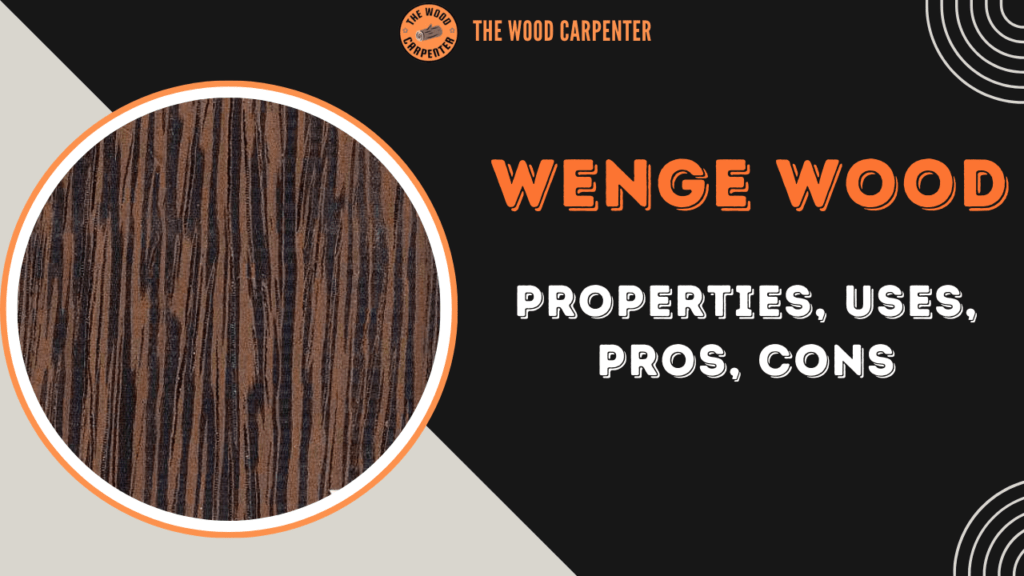
Introduction: Why Wenge Wood Catches Attention
Have you ever encountered furniture so dark and dramatic that it almost seems black? Chances are it was made from Wenge wood. Known for its unique chocolate brown tone dotted with dark veins.
Wenge is one of the most visually striking timbers available and highly sought after by architects, woodworkers and musicians for both looks and performance – yet you must take note before investing or working with Wenge.
It has its own set of unique characteristics which should be kept in mind before investing or working with it.
This guide will dig into everything about Wenge wood: where it comes from, its physical properties and how to work with it, the types of projects for which it’s best suited, pros and cons of using books like this and some frequently asked questions.
What is Wenge Wood?
- Scientific name: Millettia laurentii
- Family: Fabaceae (legume family)
- Native region: Central Africa (Congo, Cameroon, Gabon, Equatorial Guinea, Democratic Republic of Congo)
Wenge trees can be quite tall, growing upto 90ft and with trunks that might deliver big & broad boards. The wood is characterized by its dark color, sharp smell and high density. Due to these characteristics, this Wenge is considered a high-end exotic wood.
Physical Properties of Wenge
| Property | Value | What It Means |
| Color | Dark brown with black streaks | Bold, modern look |
| Grain | Mostly straight, coarse texture | Needs pore filling for smooth finishes |
| Density | ~870 kg/m³ (54 lb/ft³) | Heavy and strong |
| Janka Hardness | ~1,930 lbf | Harder than oak or maple |
| Shrinkage | Radial: 4.8% / Tangential: 8.1% | Moderate movement |
| Durability | High | Naturally resists decay and termites |
Why Wenge is Popular
Luxury Appearance: With its rich, striking grain, the design of this teak is adored by designers. It’s also perfect for modern interiors in which deep colours are sought after.
Strength & Durability: Wenge is hard and strong, and performs very well in flooring, counter tops, and other high wear applications.
Musical Quality: Guitar and bass luthiers love it because its density provides sustain and tonal depth.
Natural Resistance: Wenge is rated as very durable in regards to decay resistance.
Challenges of Working with Wenge
Wenge is sure beautiful, but it is not beginner friendly. Here’s why:
- Tool Dulling: Due to its hardness, it will dull the blades and bits quickly.
- Splintering: Edging and cross-cutting operations they will typically leave sharp splinters, some of which can cause irritation.
- Dust Hazards: This wenge dust can cause allergic reactions, eye irritation or breathing problems. So make sure when using, you always wear a mask and some type of dust extraction.
- Finishing Difficulties: Because of its coarse pores, achieving a glass-smooth finish will require a pore filling with epoxy or filler.
👉 Pro Tip: Use a sharp carbide-tipped tools and seal freshly sanded surfaces quickly to avoid the uneven absorption.
Appearance and Color Changes
Freshly cut Wenge has a deep brown tone with the black streaks. Over time, and especially when they are exposed to the sunlight, the wood can lighten slightly. So inorder to preserve its dark richness:
- Use a finish that blocks UV (like polyurethane, lacquer, or an oil with UV inhibitors).
- For deeper, nearly black colors, penetrating oils such as tung and Danish oil are suitable.
- If you would like to retain the chocolate finish, use a clear water-based finish.
Common Uses of Wenge Wood
- Flooring & Stair Treads – The hard nature of this wood is ideal for high traffic areas.
- Furniture – High-end tables, chairs, and cabinetry.
- Musical Instruments – Guitar necks, bass bodies, and drum shells.
- Interior Design – Wall panels, veneers, and accents.
- Decorative Items – Knife handles, turned bowls, and luxury accessories.
Due to price and sustainability considerations, Wenge wood is often employed in veneered panels rather than solid boards.
Pros and Cons of Wenge Wood
Pros
- Striking, bold appearance
- Extremely durable and strong
- Resistant to decay and termites
- Excellent for high-wear applications
- Adds value and luxury appeal
Cons
- Difficult to machine and sand
- Dust and splinters are hazardous
- Expensive compared to domestic hardwoods
- Limited availability due to overharvesting
- May lighten or discolor over time
Sustainability Concerns
Here’s the harsh truth: Wenge is endangered on the IUCN Red List.
Populations have dropped significantly due to the overharvesting and because of illegal logging. As a result, its ethical sourcing is now crucial.
When buying Wenge:
- Look for FSC-certified or PEFC-certified products.
- Consider engineered veneers instead of solid lumber.
- Opt for Wenge accents and details instead of large builds to reduce waste.
Buying Tips
- Check the Certification – Never buy the uncertified Wenge.
- Inspect the Grain – Straight-grain boards are easier to work than interlocked or irregular ones.
- Veneer for Cost Savings – Use Wenge veneer panels for large furniture pieces.
- Know the Alternatives – Panga-Panga (Millettia stuhlmannii) is visually similar and sometimes substituted.
FAQs About Wenge Wood
1. Is Wenge wood good for flooring?
Yes. Due to its hardness and natural durability, Wenge wood makes an excellent flooring material; however professional installation and finishing are necessary.
2. Does Wenge fade or darken with age?
Wenge also lightens a bit when exposed to the UV rays. Finish with UV resistant finishes to reduce the changes.
3. Is Wenge safe to work with?
Only if you take precautions. Always wear gloves, goggles, and a respirator. Wenge splinters are sharp and its dust can cause allergic reactions.
4. Why is Wenge so expensive?
High demand, export restrictions, slow growth and limited availability all make it expensive.
5. What woods are similar to Wenge?
Suitable substitutes could be etire, panga-panga and dark-stained walnut. Engineered veneers also offer the same appearance.
Final Thoughts
Wenge wood represents exotic luxury woodworking. Famed for its striking dark tones and extraordinary strength, Wenge is frequently chosen for high-end furniture, flooring and instruments; yet to work successfully with it requires patience, appropriate tools, and consideration for its ecological status.

